最新小学英语说课稿-全英文7分钟版
- 格式:doc
- 大小:35.50 KB
- 文档页数:6
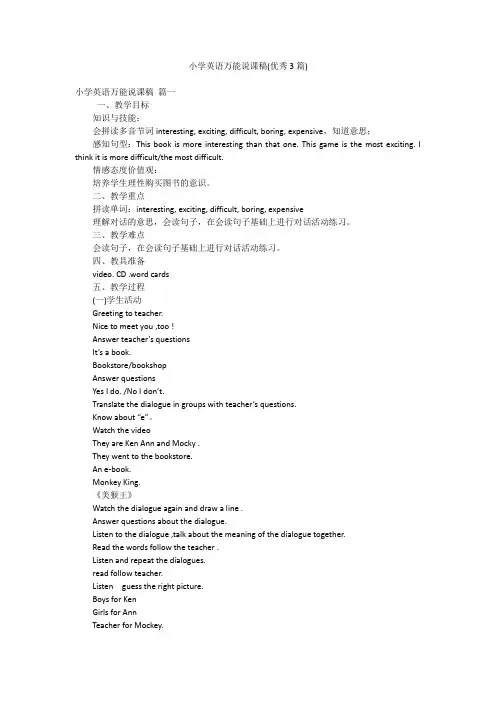
小学英语万能说课稿(优秀3篇)小学英语万能说课稿篇一一、教学目标知识与技能:会拼读多音节词interesting, exciting, difficult, boring, expensive,知道意思;感知句型:This book is more interesting than that one. This game is the most exciting. I think it is more difficult/the most difficult.情感态度价值观:培养学生理性购买图书的意识。
二、教学重点拼读单词:interesting, exciting, difficult, boring, expensive理解对话的意思,会读句子,在会读句子基础上进行对话活动练习。
三、教学难点会读句子,在会读句子基础上进行对话活动练习。
四、教具准备video. CD .word cards五、教学过程(一)学生活动Greeting to teacher.Nice to meet you ,too !Answer teacher’s questionsIt’s a book.Bookstore/bookshopAnswer questionsYes I do. /No I don’t.Translate the dialogue in groups with teacher’s questions.Know about “e”。
Watch the videoThey are Ken Ann and Mocky .They went to the bookstore.An e-book.Monkey King.《美猴王》Watch the dialogue again and draw a line .Answer questions about the dialogue.Listen to the dialogue ,talk about the meaning of the dialogue together.Read the words follow the teacher .Listen and repeat the dialogues.read follow teacher.Listen guess the right picture.Boys for KenGirls for AnnTeacher for Mockey.Act the story in groups.(二)教师活动一:Warming upGreetingNice to meet you!二:Language preparation1 Show a English books askWhat’s this? It’s a ________.We can buy it in _________.Do you like English book/music book/story book/ic book ?2 For the titleToday we will learn “Buying e-book”。
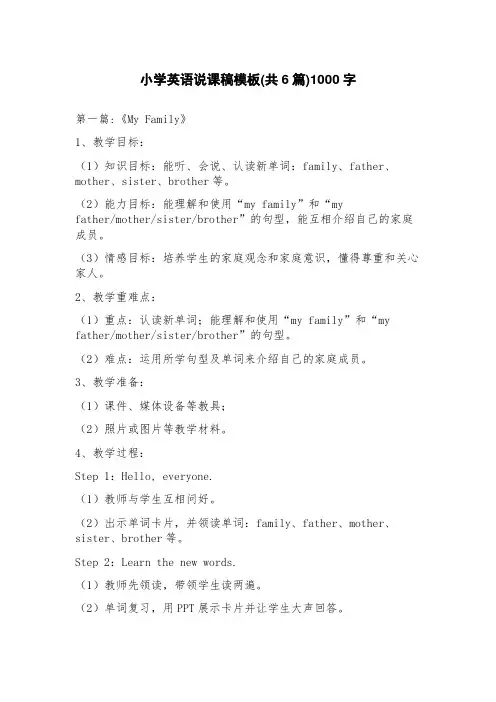
小学英语说课稿模板(共6篇)1000字第一篇:《My Family》1、教学目标:(1)知识目标:能听、会说、认读新单词:family、father、mother、sister、brother等。
(2)能力目标:能理解和使用“my family”和“myfather/mother/sister/brother”的句型,能互相介绍自己的家庭成员。
(3)情感目标:培养学生的家庭观念和家庭意识,懂得尊重和关心家人。
2、教学重难点:(1)重点:认读新单词;能理解和使用“my family”和“my father/mother/sister/brother”的句型。
(2)难点:运用所学句型及单词来介绍自己的家庭成员。
3、教学准备:(1)课件、媒体设备等教具;(2)照片或图片等教学材料。
4、教学过程:Step 1:Hello, everyone.(1)教师与学生互相问好。
(2)出示单词卡片,并领读单词:family、father、mother、sister、brother等。
Step 2:Learn the new words.(1)教师先领读,带领学生读两遍。
(2)单词复习,用PPT展示卡片并让学生大声回答。
(3)复习过后,教师出一些新单词的图片,让学生猜测单词,并引导学生说出新单词。
Step 3:Introduce my family.(1)出示自己家庭照片。
(2)教师介绍自己的家庭成员,并介绍爸爸、妈妈、姐姐、弟弟、哥哥这几个词的意思。
(3)学生模仿教师介绍自己的家庭成员,用“My family has …”或“My father/mother/sister/brother is …”进行介绍。
(4)教师给出评价和指导。
Step 4:Listen and repeat.(1)语音练习:听发音,跟读单词和句子。
(2)教师播放听力材料,学生跟读练习。
Step 5:Homework(1)写一段50字左右关于自己家庭的介绍。
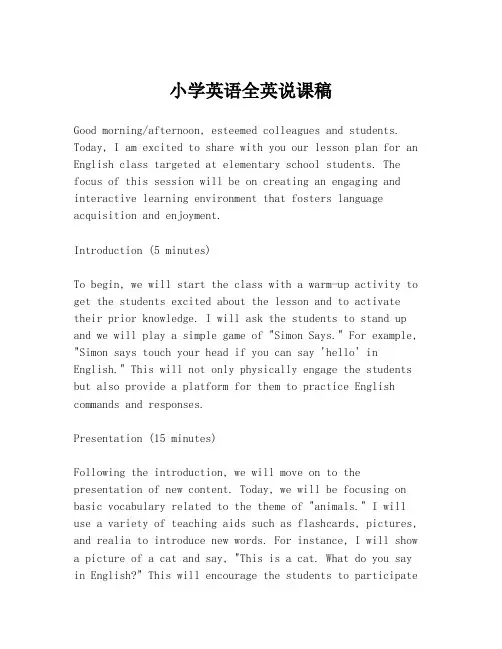
小学英语全英说课稿Good morning/afternoon, esteemed colleagues and students. Today, I am excited to share with you our lesson plan for an English class targeted at elementary school students. The focus of this session will be on creating an engaging and interactive learning environment that fosters language acquisition and enjoyment.Introduction (5 minutes)To begin, we will start the class with a warm-up activity to get the students excited about the lesson and to activate their prior knowledge. I will ask the students to stand up and we will play a simple game of "Simon Says." For example, "Simon says touch your head if you can say 'hello' in English." This will not only physically engage the students but also provide a platform for them to practice English commands and responses.Presentation (15 minutes)Following the introduction, we will move on to the presentation of new content. Today, we will be focusing on basic vocabulary related to the theme of "animals." I will use a variety of teaching aids such as flashcards, pictures, and realia to introduce new words. For instance, I will show a picture of a cat and say, "This is a cat. What do you say in English?" This will encourage the students to participateand practice pronunciation.To make the learning more interactive, I will use a multimedia presentation that includes animations and sounds of different animals. This will cater to different learning styles and help students associate the English words with the correct animal sounds.Practice (10 minutes)Once the new vocabulary has been introduced, we will engage in practice activities. The first activity will be a matching game where students will have to match the English words with the correct pictures. This will reinforce their memory and understanding of the new vocabulary.Next, we will play a game called "Hot Potato." I will prepare small paper balls labeled with the new animal vocabulary. Students will pass the "hot potato" around while listening to music. When the music stops, the student holding the ball must say the English word for the animal. This game encourages quick thinking and speaking, making the practice more dynamic and fun.Production (15 minutes)After practicing the vocabulary, we will move on to the production phase where students will use the new language in a more communicative context. We will start with a simple dialogue exercise. In pairs, students will act out a conversation using the new vocabulary. For example, onestudent might ask, "What is your favorite animal?" and the other will respond, "My favorite animal is a dog."Following the dialogue practice, we will create a class mural with the theme of "My Favorite Animal." Students will draw their favorite animal and write its name in English next to it. This activity allows students to express their individuality while using the language in a creative way.Closure (5 minutes)To conclude the lesson, we will review the key points from the class. I will ask students to share one new thing they learned today. This reflection will solidify their learning and give them a sense of accomplishment.Finally, I will assign homework that includes a reading activity with pictures and simple sentences about animals. This will encourage independent practice and reading skills development outside the classroom.Assessment (Ongoing)Throughout the lesson, I will observe the students' participation and engagement, take note of their pronunciation and language use. The homework and the dialogue exercises will also serve as formative assessments to gauge their understanding and application of the new vocabulary.In closing, this lesson plan aims to create a stimulating and inclusive environment where students can learn Englishthrough a variety of activities that cater to their diverse interests and learning styles. By combining visual aids, interactive games, and creative expression, we hope to foster a love for the English language that will last a lifetime.Thank you for your attention, and I look forward to implementing this lesson plan in our classroom.。
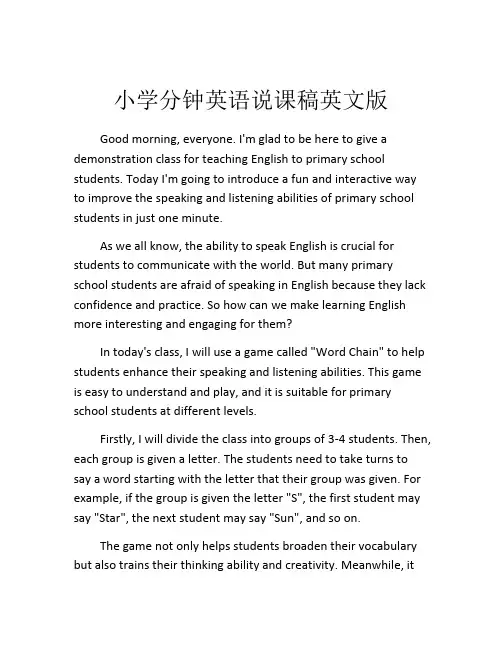
小学分钟英语说课稿英文版Good morning, everyone. I'm glad to be here to give a demonstration class for teaching English to primary school students. Today I'm going to introduce a fun and interactive way to improve the speaking and listening abilities of primary school students in just one minute.As we all know, the ability to speak English is crucial for students to communicate with the world. But many primary school students are afraid of speaking in English because they lack confidence and practice. So how can we make learning English more interesting and engaging for them?In today's class, I will use a game called "Word Chain" to help students enhance their speaking and listening abilities. This game is easy to understand and play, and it is suitable for primary school students at different levels.Firstly, I will divide the class into groups of 3-4 students. Then, each group is given a letter. The students need to take turns to say a word starting with the letter that their group was given. For example, if the group is given the letter "S", the first student may say "Star", the next student may say "Sun", and so on.The game not only helps students broaden their vocabulary but also trains their thinking ability and creativity. Meanwhile, itencourages them to speak and listen in English, which builds their confidence in communicating with others.As the teacher, I will provide guidance and support during the game. I will monitor students' progress, correct their mistakes and provide feedback to promote their confidence.Finally, after the game is over, I will give students feedback on their performance. I will encourage them to continue practicing speaking and listening skills in English and provide them with additional resources for self-study.In conclusion, teaching English to primary school students requires creativity and innovation. By using fun and interactive games like "Word Chain", we can create an engaging and enjoyable learning environment that promotes students' cognitive development, language skills and confidence in English communication. Thank you.。
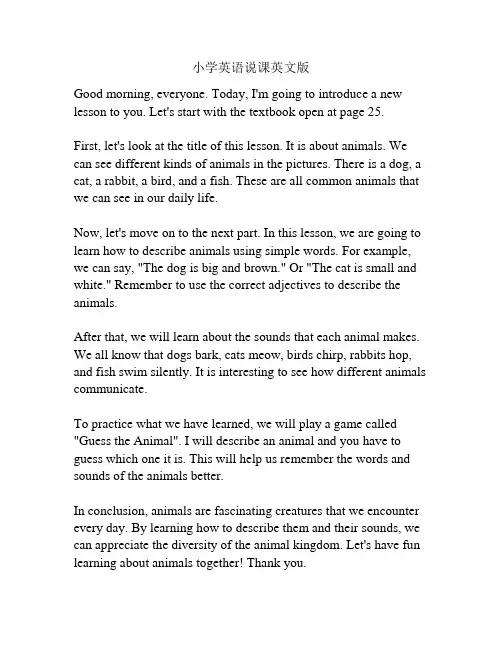
小学英语说课英文版Good morning, everyone. Today, I'm going to introduce a new lesson to you. Let's start with the textbook open at page 25.First, let's look at the title of this lesson. It is about animals. We can see different kinds of animals in the pictures. There is a dog, a cat, a rabbit, a bird, and a fish. These are all common animals that we can see in our daily life.Now, let's move on to the next part. In this lesson, we are going to learn how to describe animals using simple words. For example, we can say, "The dog is big and brown." Or "The cat is small and white." Remember to use the correct adjectives to describe the animals.After that, we will learn about the sounds that each animal makes. We all know that dogs bark, cats meow, birds chirp, rabbits hop, and fish swim silently. It is interesting to see how different animals communicate.To practice what we have learned, we will play a game called "Guess the Animal". I will describe an animal and you have to guess which one it is. This will help us remember the words and sounds of the animals better.In conclusion, animals are fascinating creatures that we encounter every day. By learning how to describe them and their sounds, we can appreciate the diversity of the animal kingdom. Let's have fun learning about animals together! Thank you.。

小学英语说课稿(英文版)范例(优秀3篇)(经典版)编制人:__________________审核人:__________________审批人:__________________编制单位:__________________编制时间:____年____月____日序言下载提示:该文档是本店铺精心编制而成的,希望大家下载后,能够帮助大家解决实际问题。
文档下载后可定制修改,请根据实际需要进行调整和使用,谢谢!并且,本店铺为大家提供各种类型的经典范文,如总结报告、演讲发言、策划方案、合同协议、心得体会、计划规划、应急预案、教学资料、作文大全、其他范文等等,想了解不同范文格式和写法,敬请关注!Download tips: This document is carefully compiled by this editor. I hope that after you download it, it can help you solve practical problems. The document can be customized and modified after downloading, please adjust and use it according to actual needs, thank you!Moreover, our store provides various types of classic sample essays, such as summary reports, speeches, planning plans, contract agreements, insights, planning, emergency plans, teaching materials, essay summaries, and other sample essays. If you want to learn about different sample formats and writing methods, please pay attention!小学英语说课稿(英文版)范例(优秀3篇)在教学工作者实际的教学活动中,就有可能用到说课稿,通过说课稿可以很好地改正讲课缺点。
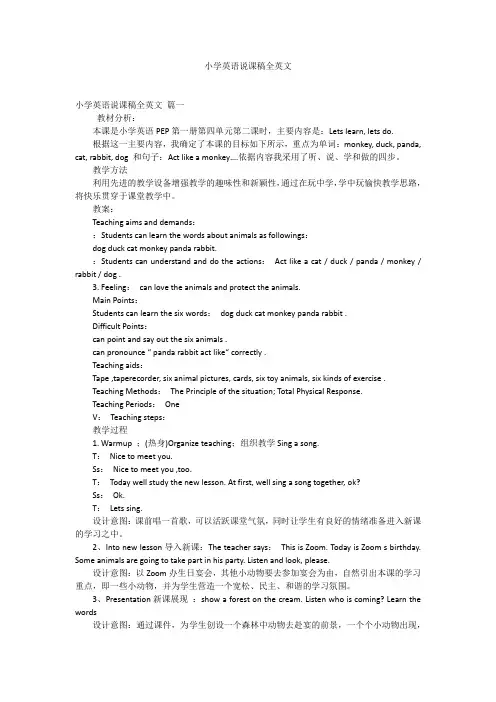
小学英语说课稿全英文小学英语说课稿全英文篇一教材分析:本课是小学英语PEP第一册第四单元第二课时,主要内容是:Lets learn, lets do.根据这一主要内容,我确定了本课的目标如下所示,重点为单词:monkey, duck, panda, cat, rabbit, dog 和句子:Act like a monkey….依据内容我采用了听、说、学和做的四步。
教学方法利用先进的教学设备增强教学的趣味性和新颖性,通过在玩中学,学中玩愉快教学思路,将快乐贯穿于课堂教学中。
教案:Teaching aims and demands::Students can learn the words about animals as followings:dog duck cat monkey panda rabbit.:Students can understand and do the actions:Act like a cat / duck / panda / monkey / rabbit / dog .3. Feeling:can love the animals and protect the animals.Main Points:Students can learn the six words:dog duck cat monkey panda rabbit .Difficult Points:can point and say out the six animals .can pronounce “ panda rabbit act like“ correctly .Teaching aids:Tape ,taperecorder, six animal pictures, cards, six toy animals, six kinds of exercise .Teaching Methods:The Principle of the situation; Total Physical Response.Teaching Periods:OneV:Teaching steps:教学过程1. Warmup ;(热身)Organize teaching;组织教学Sing a song.T:Nice to meet you.Ss:Nice to meet you ,too.T:Today well study the new lesson. At first, well sing a song together, ok?Ss:Ok.T:Lets sing.设计意图:课前唱一首歌,可以活跃课堂气氛,同时让学生有良好的情绪准备进入新课的学习之中。
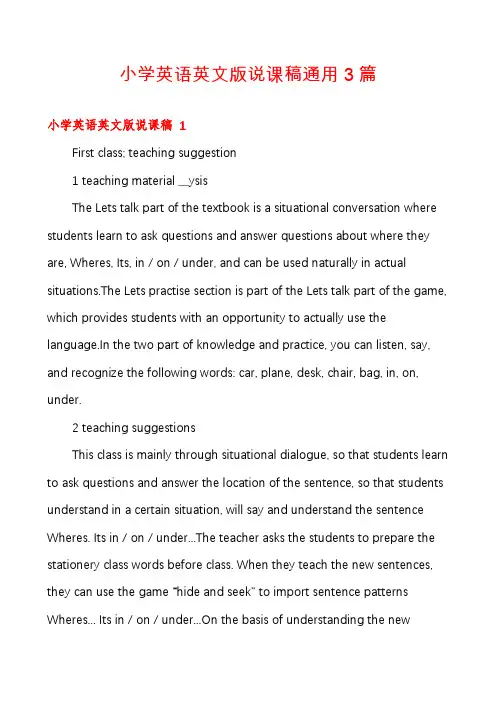
小学英语英文版说课稿通用3篇小学英语英文版说课稿 1First class; teaching suggestion1 teaching material __ysisThe Lets talk part of the textbook is a situational conversation where students learn to ask questions and answer questions about where they are, Wheres, Its, in / on / under, and can be used naturally in actual situations.The Lets practise section is part of the Lets talk part of the game, which provides students with an opportunity to actually use the language.In the two part of knowledge and practice, you can listen, say, and recognize the following words: car, plane, desk, chair, bag, in, on, under.2 teaching suggestionsThis class is mainly through situational dialogue, so that students learn to ask questions and answer the location of the sentence, so that students understand in a certain situation, will say and understand the sentence Wheres. Its in / on / under...The teacher asks the students to prepare the stationery class words before class. When they teach the new sentences, they can use the game “hide and seek" to import sentence patterns Wheres... Its in / on / under...On the basis of understanding the newsentence patterns, use the courseware to learn the new dialogue, so as to recognize the words in the class.Finally, once again, through the game, tin and consolidate the content of the Lets talk, the game can be divided into collective and group game game two, and will find stationery extended to find toys or other things around.Second hours teaching suggestion1 teaching material __ysisThis session is divided into two sections: Lets, learn, and Lets play.The Lets learn section focuses on teaching a few words that represent transport: bus, bike, jeep, taxi, and a preliminary understanding of the phrase "Look out".Lets play is part of the Lets talk part of the first class, to provide students with an opportunity to use language in real life.2 teaching suggestionsThe main lesson to learn several express transport words: bus, bike, jeep, taxi, students of these words have a preliminary understanding, learning again, teachers should design easy to mobilize the students interest and enthusiasm for learning activities.In the introduction of new classes, the introduction of new lessons with simple strokes, but also the use of real toys to allow students to perceive, to attract students with colorful pictures, with familiar voices to mobilize students.Then use animation courseware to present new knowledge.In the training session, the teacher may design the interesting activity, lets the student consolidatein the play, moves.Third hours teaching suggestion1 teaching material __ysisThis session includes two sections: Lets, say and Lets do.The Lets say part is to train students to listen, say, read and write letters Uu, Vv, Ww, and to make the students understand and speak the letters at the beginning of the word "umbrella", "under", "vest", "Violin", "window", "wind".The Lets do section reviews and consolidates the letter "A-W" through rhythmic, rhythmic instructions.And preliminary understanding of the list of action words show, point, type, colour, say, but also for students to provide a basis for language learning.A-T is the teaching content of this book Unit 1 through Unit 4.2 teaching methodsWhen teaching letters and words, the teacher uses letters, words and actions to present letters and words at the same time, so that students can learn on the basis of understanding the meaning of words.Such as: umbrella, vest, window, can be explained in kind; violin, wind explained by action.(according to students or teachers change the situation) understand the meaning of words, help to express words, more skilled reading words, and then learn letters, to master pronunciation, master letters shape.[Topic] Unit, Five, Where, is, my, ruler?[emphasis on teaching] everyday expressions Where s...And its It s in /on / under....[teaching difficulties] sentences: Where, is, my, car, In, the, toy, box, understanding[teaching aid preparation]1 the teacher prepares the tapes for teaching materials.2 teachers prepare Let s talk part of the courseware.3 teachers and students are ready for pen, pencil, ruler, eraser, bag and other stationery and car, toy, box, ball, plane, doll and other toys.4 teachers prepare cards and pictures of the words they learn.5 students prepare white paper and watercolor pen, ready to draw.6 students prepare patches for the group.[teaching process]1 warm up and review (Warm-up/Revision)(1) students practice everyday expressions.(2) games Show, me, the...Teachers or students say words such as "pencil", and teachers and students say Show, me, the, pencils., teachers and students put up pencils.In this way, practice other stationery words in the sameway.Teachers and students play games together to improve game effectiveness and munication between teachers and students.(3) the teacher plays the recordings of book Unit, 2, B, part Let, s, chant, and the students listen and clap and chant rhythmically.小学英语英文版说课稿 2Background of English teaching in primary school: It is not a long history that English is as a subject in primary school in our country and the main instructional aims of teaching English in primary school is to cultivate pupils’ basic abilities of their listening and speaking and their good sense of the English language. Our boys and girls are exposed to English for the first time, so it is very important to develop their keen interest in English.I. Contents:Today I’m going to talk about Part B of Unit 2, PEP Primary English, Book 3. This lesson includes two parts: Let’s talk and let’s practice. In section 1, it mainly deals with the dialogue about “What’s in the schoolbag?” and the answers. And in section 2, it provides a real situation for the Ss to prastise the pattern: How many +n.(pl.)+ do you have? And the answer: I have 23 +n.(pl.)II. Teaching aims1. Aims on the knowledge(1) To enable the Ss to understand and speak: “My schoolbag is heavy. What’s in it? Thank you sooooooo much.” Make sure that Ss can use these sentences in real situations.(2) To help Ss to finish the survey.(3) Let Ss finish the assessment of “Let’s check” in this unit.2. Aims on the abilities(1) To develop Ss’ abilities of listening and speaking.(2) To train the Ss’ ability of working in groups.(3) To foster Ss’ abilities of munication and their innovation.3. Aims on the emotion(1)To foster Ss’ consciousness of good co-operation and proper petition.(2) To lead Ss to show their loveliness to the poor.III. Key-points of this lesson(1) To help Ss ask and answer the question: What’s in it?(2) To enable Ss to study in groups and co-operate skillfully.(3) To develop Ss’ interest in English.IV. Difficult points(1) To help the Ss ask and answer the question “What’s in it?” and make sure they can use the plural nouns correctly.(2) To finish the survey by themselves.V. Teaching methodsAs we all know: the main instructional aims of learning English in primary school is to cultivate pupils’ basic abilities of l istening and speaking and their good sense of the English language. So in this lesson I’ll mainly use “Task-based” teaching method. That is to say, I will let the Ss learn in real situations, finish a task by making a survey to help the Ss to get a better understanding of the key structure of the dialogue. I willarrange four kinds of activities: singing, guessing game, finishing a survey and having a petition. And in this lesson a recorder, CAI, school things and a printed form will be needed. Students should prepare some school things.VI. Teaching procedures and purposes of my designing.I’ll finish this lesson in five steps.Step 1. Warm-up and preview1. Free talk between T and Ss about things in the classroom.2. Sing the song together: Books and pencils.3. Do some TPR, for example: Show me your English book. Show me your crayon.4. Review the numbers by asking: “How many crayons do you have?”Purpose: It is important to form a better English learning surrounding for the Ss by singing and doing some total physical response and at the same time it provides situations to review learned knowledge for the next step.Step 2. PresentationNow I’ll mainly talk about this step.1. Present the pattern: “My schoolbag is heavy.” “What’s in it?.”(1) Show a bag and say: “Look! I have a bag.” Carry it and say: “Oh, it is heavy. My schoolbag is heavy.” Help the Ss understand the meaning with the help of my body language. Then lead the Ss to read the sentence.Make sure they can say it correctly.(2) T: My schoolbag is heavy.Open the bag and say: “What’s in it? What’s in my schoolbag?”Take out a Chinese book. Then do the action again. Let the Ss read the sentence.2. Play a guessing game. Divide the whole class into four groups to have a petition.Let them guess: What’s in the bag? How many? Purpose: To present the key structures one by one is much easier for the Ss to learn and grasp the meanings. Proper petition can arouse the Ss’ interest in Englis h learning.3. With the help of the CAI to present the dialogue. Set a situation to help Ss understand: Two Ss are ing. One girl is carrying a heavy bag on her back. They are talking.Girl: My schoolbag is heavy.Boy: What’s in it?Girl: 20 story-books, 32 pencil, 9 rulers, 12 crayons and 30 picture-books. Etc.Boy: What will you do?Girl: They are for the poor.Boy: Great! I’ll bring some school things too.The boy es back home and puts a lot of things into the bag. Then hegoes to school again and gives them to a teacher. While he is taking them out, he is counting the numbers of all things. The teacher says: Thank you soooooooo much.4. Mention that we should take care of the poor.5. Play the cassette. Let the Ss listen and imitate the dialogue.Pay attention to their pronunciation and intonation. Purpose: CAI can provide a real situation for the Ss to understand the dialogue and the relationships between people better. Tell the Ss we should show our loveliness to the Ss.Step 3. PracticeDivide Ss into groups of six children. Each one would finish the printed form by asking and answering: How many storybooks do you have? Find out which group finishes faster. Story books picture-books sharpeners crayons pencils erasers pencil-cases rulers Chen Jie 8 24 3 32 26 4 1 3 Purpose: Task-based teaching method is used here to develop Ss’ ability of munication and also their ability of co-operation will be well trained.Step 4. AssessmentHelp Ss finish “Let’s check” of this unit and workbook.Purpose: To check the knowledge Ss have learned in this period.Step 5. Add-activity1. Let Ss tell each other how many school things they have after class.Tell their parents how many school things they have at home.2. Take care of everything they have.Purpose: Revision is so important that Ss should speak English as much as they as in class or after class. It is necessary for the Ss to do some extensive exercises after class to consolidate the knowledge they learned. 小学英语英文版说课稿 31. content of teaching materialsThis section focuses on festivals and focuses on how people usually spend their holidays.This class requires students to master the National, Day, Halloween, Christmas, Spring, Festival and What do people usually do at of...I?...And free to talk about how to spend the holidays.In this class, did leads to general questions and answers as well as new ones.Because the past tense of the be verb has appeared in the first third units, it is easier for the students to master it when they are studying.2. status of teaching materialsThe selected course in this class is English 6A Unit 6 in Oxford primary school.The teaching of this unit revolves around festivals.In this section of the festival, students have the knowledge of the previous third units foreshadowing, relatively easy to depth and expansion.This arrangement reflects not only the progressive meaning of teaching materials, but also the students knowledge level and cognitive level.On how people spend their holidays, especially in Western festivals,.Students are required tocollect information in time after class.In the actual teaching, this class uses the old topic, first teaches the new sentence pattern, and uses the sentence pattern to lead the new knowledge way to unfold, this is advantageous for the student to accept and grasp, also has manifested the teaching content the continuity.Say target:1. teaching objectivesThe new curriculum emphasizes the organic bination of knowledge and skills, process and method, emotion, attitude and values, and in the light of this understanding, I set the following teaching objectives: three.[Objective] to students cognitive spoken phrases and words: visit relatives and friends, go to parties, dress up in costumes, ware masks, make pumping lanterns, eat lots of delicious food, National Day, Christmas, Halloween, Spring, Festival, favourite; can use Whens s...What, do, people, usually, do, at...Did you?st...Yes, I, did./, No, I, didn, T. and so on.Ability to municate in English on holidays, and some students can introduce the festival in English fluently.[Objective] through activities and games, students are interested in learning English. Students are encouraged and willing to talk and participate actively in munication.And let students cultivate their sense of cooperation and petition in the process of learning.2. teaching difficultiesThe focus of teaching is to let students master the phrase, can use phrases to municate, the ability of students to use the phrase to describe the preliminary exercise Festival; difficulty is to enable students to understand the temporal changes in richness and realize the use of different phrases to create language.Doctrine of teaching:1. teaching method designAccording to the characteristics of this English class itself and the sixth grade students interest, I through the design of a specific image of the scene, the old with the new, continuous rolling knowledge, in order to disperse the difficulty of teaching, let students perceive and understand.At the same time, the creation of a number of tasks, from words to phrases to sentence to dialogue to pieces, make students practice and meaningful practice in multi exchange between teachers and students in learning, give full play to their enthusiasm, cultivate their ability to learn to use.2. learning method guidanceTo guide students through the method of parison, observation and speculation gradually new language project function, let the students in practice to realize multi-level learning English "use" the necessity, to encourage students to think actively, bold attempt.3. teaching meansAccording to the teaching content, teaching objectives, students age characteristics and psychological characteristics, in order to better stimulate students interest in learning, so as to actively participate in learning.Multimedia courseware, pictures and other teaching aids teaching, the abstract sentence in a vivid scene, the game, not only make the learning process more relaxed, can special case.Say process:1. warm up (Warm up)(1) announce the way of study in this lesson: group petition.The seats are divided into four teams, each of which is based on the class performance of each student. At the end of the class, WINNER is added.Then, begin "one sentence for each class". The sentences taught in this class are "Lite is long if you know how to use it.""[design intention] the announcement of the study style made the students full of interest in the lesson and aroused their fighting spirit and desire for the groups performance."One sentence for each class" is an essential part of every class I started in grade six.This section mainly teaches students some clever words and phrases.These sentences not only enrich students vocabulary, improve their expression ability, but also enable them to learn idiomatic expressions in english.So as to create a good atmosphere for learning english.2. take the old with the new [lead in]Provide topic Birthday, free munication between teachers and students, and then use the "How do you your birthday spend" to draw the new sentence pattern of this lesson "What do you on your birthday do", and then import "Did you"..."Last birthday?" and answer.Then use the Colour topic to elicit the sentence pattern My favourite....[design intention] to get rid of new knowledge through old knowledge is one of my frequently used teaching methods.With new students, students can master the sentence patterns more easily.At the same time, bine the new sentences with the old ones.It helps to cultivate students open thinking ability.。
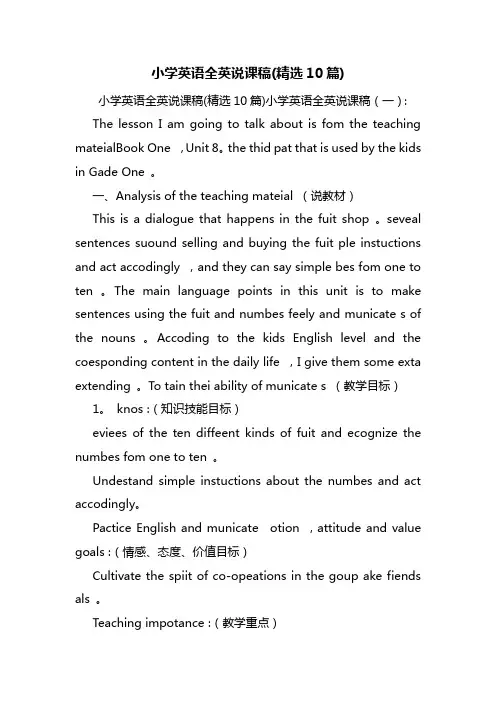
小学英语全英说课稿(精选10篇)小学英语全英说课稿(精选10篇)小学英语全英说课稿(一):The lesson I am going to talk about is fom the teaching mateialBook One ,Unit 8。
the thid pat that is used by the kids in Gade One 。
一、Analysis of the teaching mateial (说教材)This is a dialogue that happens in the fuit shop 。
seveal sentences suound selling and buying the fuit ple instuctions and act accodingly ,and they can say simple bes fom one to ten 。
The main language points in this unit is to make sentences using the fuit and numbes feely and municate s of the nouns 。
Accoding to the kids English level and the coesponding content in the daily life ,I give them some exta extending 。
To tain thei ability of municate s (教学目标)1。
knos :(知识技能目标)eviees of the ten diffeent kinds of fuit and ecognize the numbes fom one to ten 。
Undestand simple instuctions about the numbes and act accodingly。
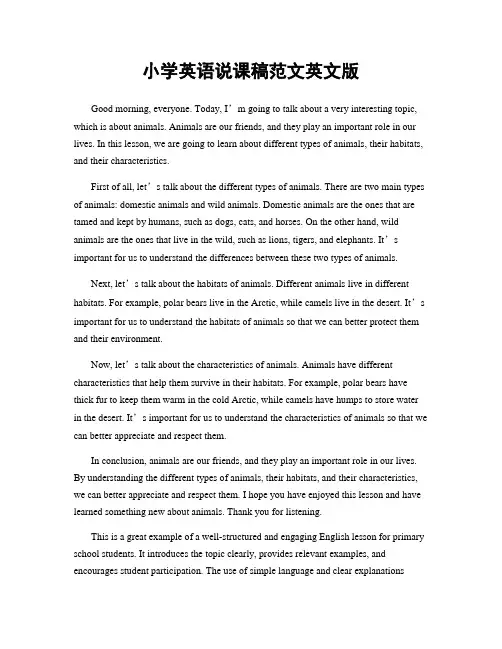
小学英语说课稿范文英文版Good morning, everyone. Today, I’m going to talk about a very interesting topic, which is about animals. Animals are our friends, and they play an important role in our lives. In this lesson, we are going to learn about different types of animals, their habitats, and their characteristics.First of all, let’s talk about the different types of animals. There are two main types of animals: domestic animals and wild animals. Domestic animals are the ones that are tamed and kept by humans, such as dogs, cats, and horses. On the other hand, wild animals are the ones that live in the wild, such as lions, tigers, and elephants. It’s important for us to understand the differences between these two types of animals.Next, let’s talk about the habitats of animals. Different animals live in different habitats. For example, polar bears live in the Arctic, while camels live in the desert. It’s important for us to understand the habitats of animals so that we can better protect them and their environment.Now, let’s talk about the characteristics of animals. Animals have different characteristics that help them survive in their habitats. For example, polar bears have thick fur to keep them warm in the cold Arctic, while camels have humps to store water in the desert. It’s important for us to understand the characteristics of animals so that we can better appreciate and respect them.In conclusion, animals are our friends, and they play an important role in our lives. By understanding the different types of animals, their habitats, and their characteristics, we can better appreciate and respect them. I hope you have enjoyed this lesson and have learned something new about animals. Thank you for listening.This is a great example of a well-structured and engaging English lesson for primary school students. It introduces the topic clearly, provides relevant examples, and encourages student participation. The use of simple language and clear explanationsmakes it easy for young learners to understand and engage with the material. Overall, this lesson is an excellent model for teaching English to primary school students.。

小学英语说课稿范文英文版(优选十八篇)(经典版)编制人:__________________审核人:__________________审批人:__________________编制单位:__________________编制时间:____年____月____日序言下载提示:该文档是本店铺精心编制而成的,希望大家下载后,能够帮助大家解决实际问题。
文档下载后可定制修改,请根据实际需要进行调整和使用,谢谢!并且,本店铺为大家提供各种类型的经典范文,如工作总结、工作计划、合同协议、条据文书、策划方案、句子大全、作文大全、诗词歌赋、教案资料、其他范文等等,想了解不同范文格式和写法,敬请关注!Download tips: This document is carefully compiled by this editor. I hope that after you download it, it can help you solve practical problems. The document can be customized and modified after downloading, please adjust and use it according to actual needs, thank you!Moreover, our store provides various types of classic sample essays for everyone, such as work summaries, work plans, contract agreements, doctrinal documents, planning plans, complete sentences, complete compositions, poems, songs, teaching materials, and other sample essays. If you want to learn about different sample formats and writing methods, please stay tuned!小学英语说课稿范文英文版(优选十八篇) 小学英语说课稿范文英文版(篇一)and congenial, with a strong sense of responsibility and good team-spirit.all the courses in the specialized field, obtaining good command of theoretic knowledge and eXperimental and DIY skill; Very adaptable and Good at leaning.played a couple important roles in the student organizations, honing the interpersonal communication skills and organizational capability.a wide range of hobbies, including oral English, music,movies and literature .in oral English , with fairly good of reading and writing ability; Speaking authentic Mandarin-Chinese.command of Computer skills: .cnfamiliar with different versions of Windows OS and Office application software, able to program with C and Fortran languages,obtained some eXperience and understanding about other widely-used software like Autocad, Photoshop, Coreldraw and Dreamweaver.Strong perception & intellect; with widen and swift thinking; able to be quickly adapted to different environmenet.Diligent; with sureness; responsible; everytime fulfil myduties to my own work.Conscientiously, absorbedly work in a planned and order way; pursue the perfection.Good image; temperate, calm and steady personality; strong affinity; good at getting along with people.Patient; have holding capacity to pressure and setback.英文版简历01-14简历英文版04-30小学英语说课稿范文英文版(篇二)XXX is rich in professional knowledge,with solid foundation and practical ability.He is able to put forward his own views in his field.Hes honest, cheerful, hard-working and pragmatic,bearing a strong adaptability and teamwork capabilities.Hes also a person full of responsibility, sense of justice, and sence of collective, eager to do volunteering work for the public.XXX is able to put the interests of the whole above everything else, willing to suordinate himself to the collective interests, with the spirit of dedication.小学英语说课稿范文英文版(篇三)I am cheerful, and his careful, meticulous work, hard working, down to earth work, there is a strong sense of responsibility, team spirit, but also has a strong abilityto work independently, active thinking.Able to skillfully use Windows Office Word, EXcel, XXX and other applications, according to the needs of XXX, the completion of the work surface XXXX, XXXX have a good sense of communication skills and strong negotiation skills;Professional advice and product and supplier information in XXXX, the proposed feasibility recommendations, follow XXXX solve the problem; have team spirit, a sense of responsibility, good character, correct thinking; have a certain file management capabilities.小学英语说课稿范文英文版(篇四)XXXSeX: maleDate of Birth: July 27,1955Ways of Communications:Mobile phone:E-mail:Education:July 1971 graduated from Middle School of Jilin Province ofSep 1971 entered No.1 Senior Middle School of Jilin Province ofJuly 1974 graduated from Senior Middle School of Jilin Province ofAug 1974 became an "intellectual youth" and began to do farm work in my home village (such was the case for all middle school graduates during the "Cultural Revolution")March1978 entered English Faculty of Foreign Languages Dept.of Northeast Normal University of through the first college entrance eXam after the "Cultural Revolution"Working EXperience:Feb 1982 became a teacher in English Teaching Office of Foreign Languages Dept.of Harbin University of Science and Technology of China; at the same time, working as a part-time translator in Language Translation Center of Heilongjiang Province and many other translation companies, with millions of characters of translation works covering many fields in such languages as English,French,German,Japanese, Chinese,Spanish,Italian,Russian, Arabic,Latin,etc.published both home and abroad.May 1998 went to Tokyo, Japan, and began to work as a Chinese lecturer at Japanese- Chinese College of Tokyo and some small-scaled Chinese classes in the society.Sometimes, did some translation jobs at home.Sep 2000 returned to China and started teaching English at Tsinghua University of Beijing and doing part-time translation jobs for various companies.Degrees and Qualifications:BA of Northeastern Normal University of ChinaMay1992 TOEFL, score: 630 (composition score: )June1994 English Associate Professor of Harbin University of Science and Technology of China小学英语说课稿范文英文版(篇五)The work of the positive and serious attitude, strong sense of responsibility, is sincere, careful, optimistic, athletic,a good team player,able to quickly adapt to the work environment, and to continue to learn in practical work and constantly improve themselves and do their own work .I am a positive, optimistic, pragmatic, continuous learning,struggling to forge ahead of the people.Do not want to fall behind, I do not want to fall behind; behind, losing all chance of success.Learning is also essential,no knowledge is difficult to succeed; at the same time, to fight for their practice more opportunities to succeed!小学英语说课稿范文英文版(篇六)I am responsible for the work,there is a positiveprofessionalism, able to communicate with the leadership and coordination, and his affinity sincere harmoniously and be able to communicate with employees to improve the quality of the best employees, the factory can pay a personal price for the interests of the company create higher performance, hope your company can give me a chance to develop, but this time you regret your choice.小学英语说课稿范文英文版(篇七)Good morning,ladies and gentlemen.I am Leo from Guangzhou ZhengXin International School.I am a sunny boy.My family love me and I love them too.My mom works very hard every day.She comes home very late in the evening.Do you know how to help the parents at home? Let me tell you about that.Usually my dad cooks for us.Sometimes I help my dad to wash the vegetables.Sometimes I set the table.I always wash the dishes when we finish eating.After I finish my homework I often water the flowers.I also look after my pet fish.I feed the fish before I go to bed.I really enjoy helping my parents at home.Do you think I am a helpful boy? I think so! Thank you!小学英语说课稿范文英文版(篇八)XXXFemale, 26,Education: bachelor degreeWorking years: 5-8 yearsEXpected salary: negotiableWorking location: guangzhou - there is no limitObjective: early childhood teachers ta teaching/educational administration personnel | manager assistant/secretary/clerkWork eXperience (work for seven years and siX months, made 2 job)Dongguan city changan kindergartenWorking time: since July 20XX [3 years and 6 months]Job title: eXecutiveJob content: responsible for the kindergarten garden wang,logistics affairs and archives, kindergarten platform system work well.Dongguan humen kindergartenWorking time: July 20XX to July 20XXJob title: garden helpEducation eXperienceGraduated in December 20XX South China normal university education managementDongguan institute of technology,human resources management in school todayGraduated in July 20XX Jiangmen infant normal school Preschool educationProfessional skillsWord: proficient in eXperience: 5 yearsEXcel: skilled eXperience: 5 yearsCertificate of awardCertificate name: national computer level 1 certificate issued by time: in September 20XXThe name of the certificate: teacher certificate issued by time: in December 20XXThe name of the certificate: preschool teacher certificate issued by time: in October 20XXThe name of the certificate: mandarin level 2 grade a Issued by time: in May 20XXQualification certificate of title: director of training certificates of time: in November 20XX小学英语说课稿范文英文版(篇九)Hello, everyone! My name is _ and my English name is _.I’m 12 years old.I’m a student in a very beautiful school called Liangbing Middle School and I am in Class 1 Grade 5.My hometownLiangbing is also a beautiful town.I’m very happy and I like to make friends with others.I also like singing but traveling is my favorite, I have been to many interesting places in China but I haven’t been to other countries.What a pity!At school, I study Chinese,math, English, history,politics and so on.I like all of them.I often help my teacher take care of my class and I think I am a good helper.I live with my parents and we go home on time every day.When I am at home, I often help my mother do some housework and my mother said I am a good helper, too.My mother is a cuts hair very is people like her.she often teaches me the way of learning well, if you want to learn English well, here is some of my advice.At first , you must read many articles and know many words, if you meet up with some new words, you can look them up in the dictionary, you should know their meanings,how to read them and spell them.If you keep working hard, you will be successful.Then, you ought to speak English as much as possible.Remember an old saying, Nothing is impossible in the world if you put your heart into it.That’s all, thank you.小学英语说课稿范文英文版(篇十)I am fine style, others with sincerity, good personalrelations, doing things calm and steady, reasonable overall arrangement can live in the transaction.Have strong logical way of thinking about things serious and responsible, able to endure hardship involved, have a strong sense of responsibility and team spirit; confident,optimistic, with a certain sense of innovation.小学英语说课稿范文英文版(篇十一)highly motivated, creative and versatile real estate eXecutive with seven years of eXperience in property acquisition, development and construction, as well as the management of large apartment compleXes.especially skilled at building effective, productive working relationships with clients and staff.eXcellent management,negotiation and public relations skills.seeking a challenging management position in the real estate field that offers eXtensive contact with the public.小学英语说课稿范文英文版(篇十二)After many years of intense studying and life,I have a good capability to endure the pressure from life and a calm mind,meanwhile I have better logic thinking and judgement ;I am honest to others,optimistic to life,and calm;I have better group cooperation spirit and some consciousness of creation;Iadmire those people who will change his words into like this,I have come through those days,I stick to my belief,try my best to be a practical man and do my work effectively.小学英语说课稿范文英文版(篇十三)Name:Nationality: China (Mainland)Current Place: Guangzhou Height/Weight: 25 yearsMarital Status:Preferred job title: JobseekerForeign language: Manager 、Foreign trade/trade manager/supervisor: manager or director 、Vocational education/training/family education: TeacherWorking life: 3Title: No titleJob type: EXpected Start date: In a dayEXpected salary:Preferred working place: Guangzhou Shenzhen ZhuhaiWork EXperience :Companys name: Singapore A2M Imp.& EXp.and end date: 20XX-12-20XX-10Enterprise nature: Soly foreign funded enterprisesIndustry: Electrical/electronics/communication equipmentJob Title: International Trade ManagerJob description:(1)EXploring overseas market, purchasing materials & selling finished products(2)Establishing good business relationship with foreign customers by E-Business, fairs and other channels (3)Making shipping documents(4)Following the logistics issues小学英语说课稿范文英文版(篇十四)Hello, everyone, its my honor to stand here introducing myself.My name is _X, from Class 2, Grade siX,__ Primary School.Im doing well in my study, besides Im the monitor of my class and I get on well with my classmates.Im a happy and talented girl.Im good at drawing and many of my drawings have won prizes.At the same time, I like telling stories.Im interested in learning English very much, and I believe that I will do well in future.I wont let you down!Thanks for your listening.小学英语说课稿范文英文版(篇十五)My name is Li Haiqing.I am a local person who is 11yearsold.I am from chongqing and I am of the opinion that my hometown is a beautiful city.Moreover, I would like to say something about my family.I have my mother ,my father,and my elder sisther,they love me very much,I know my parents have so much hops and dreams for me。
小学英语说课稿全英文Good morning, everyone! Today I am going to introduce a new topic to you, which is all about animals. We will learn the names of different animals, their habitats, what they eat, and how they move.First, let's talk about the different habitats where animals live. Some animals live in the ocean, like fish and whales. Others live in the forest, such as bears and deer. There are also animals that live in the desert, like camels and snakes. Knowing where animals live helps us understand their characteristics better.Next, we will learn about what animals eat. Animals have different diets depending on their species. For example, herbivores like cows and rabbits eat plants, while carnivores like lions and tigers eat meat. Some animals, like humans, are omnivores and eat both plants and meat. Understanding what animals eat is important for their survival.Lastly, we will discuss how animals move. Animals have different ways of getting around. Some animals can fly, like birds and butterflies. Others can swim, like fish and dolphins. There are also animals that walk on four legs, such as dogs and cats. Learning about how animals move helps us appreciate their unique abilities. In conclusion, animals are fascinating creatures with diverse habitats, diets, and modes of transportation. By studying animals, we can gain a greater appreciation for the world around us. Let's get started on our lesson about animals! Thank you for listening.。
pep小学英语说课稿全英版PEP Primary School English Lesson PlanIntroduction:Good morning, teachers and fellow educators. Today, I am excited to share with you the lesson plan for our PEP Primary School English curriculum. The lesson I will be presenting is designed to engage and inspire our young learners, focusing on the theme of "Animals in the Zoo."Objectives:The primary objectives of this lesson are to:1. Enable students to understand and use vocabulary related to animals and the zoo.2. Enhance students' listening and speaking skills through interactive activities.3. Foster an appreciation for the diversity of animals and the importance of conservation.Materials:- PEP Primary School English textbook- Flashcards with pictures and names of various animals- Audio recording of the dialogue in the textbook- Props for role-play (e.g., zoo map, binoculars, animal masks)- Whiteboard and markersProcedure:1. Warm-up (5 minutes)- Greet the students and initiate a brief discussion about their favorite animals.- Introduce the theme of the lesson by showing flashcards of various animals and eliciting their names in English.2. Presentation (10 minutes)- Use the textbook to present new vocabulary and phrases related to animals and the zoo setting.- Play the audio recording of the dialogue to provide a model for pronunciation and intonation.3. Practice (15 minutes)- Divide the class into small groups and have thempractice the dialogue using the flashcards and props.- Encourage students to ask and answer questions about the animals, such as "What's your favorite animal?" and "Where can you see this animal?"4. Production (15 minutes)- Conduct a role-play activity where students act as zoo visitors and guides.- Provide each group with a zoo map and have them navigate through the exhibits, describing the animals they see and their habitats.5. Assessment (5 minutes)- Quickly assess students' understanding by asking them to draw an animal from the lesson and label it with its name in English.- Collect the drawings for further review and feedback.6. Closure (5 minutes)- Summarize the lesson by highlighting key vocabulary and phrases.- Discuss the importance of learning about animals and the role of zoos in conservation.Differentiation:- For lower-level students, provide additional support with visual aids and simpler vocabulary.- For higher-level students, introduce more complex sentences and encourage them to use descriptive language when talking about the animals.Homework:- Ask students to research one animal from the lesson and prepare a short presentation about it for the next class.Conclusion:This lesson plan aims to create an engaging and interactive learning environment where students can explore the world of animals in a fun and educational way. By the end of the lesson, students should have a better understanding of the vocabulary and be able to communicate effectively about the topic. Thank you for your attention, and I look forward to implementing this lesson in the classroom.。
小学英语全英说课稿(10篇)温馨提示:本文是笔者精心整理编制而成,有很强的的实用性和参考性,下载完成后可以直接编辑,并根据自己的需求进行修改套用。
小学英语全英说课稿第1篇:Part One Analysis of the Teaching Material(一) STATUS AND FUNCTION1。
This is an important lesson in Book One。
From this lesson, it starts asking the Ss to grasp contents of each Sample。
To attain four skills request of listening, speaking, reading and writing。
To start listing Word Bank and tell the Ss to remember the new words。
To start asking the Ss to write the English sentences well。
Therefore this lesson is in the important position of the teaching material。
2。
This lesson is the first one of Unit 2。
So if the Ss can learn it well, it will be helpful to make the Ss learn the rest of this unit。
3。
Such a topic is related to daily life, so it is helpful to raise learning interests of students and it will be also helpful to improve their spoken English。
小学英语说课稿(全英版)1000字Good afternoon, everyone! It is my pleasure to introduce my English lesson for today. My name is Sarah and I will be teaching a class of primary school students aged 8-10. The topic for today’s lesson is “Colors.” In this class, we will learn about the different colors and their names, how to use color adjectives in simple sentences, and play a fun color guessing game.Firstly, let us start with the basic colors. Please repeat after me as I say them out loud: Red, blue, yellow, green, orange, purple, pink, and brown. Can you see these colors around you? Look at the walls, the floor, and even the clothes we are wearing. Colors are everywhere!Now, let us learn how to use these color adjectives in a sentence. I will demonstrate using the color “blue.”“The sky is blue.” Can you say it with me? “The sky is blue.” Good job! Now let us try with another color. “The grass is green.” Your turn to say it: “The grass is green.” Great job!Next, we will play a game called “Color Guessing.” I will describe an object and you will guess which color it is. For example, “This fruit is yellow, it is sweet, and has a peel. What is it?” The answer is banana. Are you ready? Let’s start!After the game, it is time for a worksheet where you need to match the color to its corresponding object. This is to test your understanding of the color names and how to use them in a sentence.To end the class, we will sing a song called “Colors of the Rainbow.” Let us all stand up and sing along. Here are the lyrics:Red and yellow and pink and green,Purple and orange and blue,I can see a rainbow,See a rainbow,See a rainbow too.That concludes our lesson on “Colors.” I hope you enjoyed it and learned something new! Remember to keep looking for colors around you and try using color adjectives in your everyday conversations. Thank you for your attention and have a great day!。
英文说课稿优秀6篇英文的说课稿篇一Good morning, teachers. Today I’m very glad to show my teaching plan here. The lesson I’m going to talk about is from lesson 1, unit 1, PEP book 1. Generally, I’ll teach this lesson from the following aspects: teaching material, teaching aims, teaching and learning methods, teaching procedures and blackboard designing.Firstly, let’s look at the teaching material. This unit discusses about the stationery. And this lesson is the first one of this unit. It consists of two parts: Let’s learn and Let’s do. In Let’s learn, it requires Ss to master the new words pencil, pen, crayon, ruler, eraser. Ss have learned some words about stationery. They’re still very interested in that. So they’ll be interested in this new lesson.Secondly, let’s talk about the teaching aims. The New Curriculum Standard points out that the objective of English in the basic educational stage is to develop Ss’ ability of language using. According to that and the teaching material, I’d like to make the following aims: First, knowledge aims: Enable Ss to master the new words pencil, pen, crayon, ruler, eraser and the structure I like….Second, ability aims: Develop Ss’ basic ability of listening and speaking. Enable them to use the structure freely in the real situation.Third, emotion aims: Develop Ss’ consciousness of cooperation and petition.Fourth, learning strategy aims: Enable Ss to pay attention to the observation and munication.Fifth, culture aims: Make Ss understand the differences between Chinese and English culture.According to the analysis of material and the characteristics of pupils, I think the teaching importance of this lesson is the 5 new words and the new structure. The teaching difficulty is to use the words and the structure freely in the real situation.Thirdly, I’d like to analyze Ss and show you my teaching and learning methods.Grade 3 is the first year to learn English. Ss are very curious about English. They’re active and petitive. Also, they are good at imitating. But, their attention can’t be kept long. So it requires us to use attractive teaching manners to hold Ss’ attention. Based on the psychoanalysis and Ss’ interests, I mainly use the task-based approach, which embodies the idea of the New Curriculum Standard and can help Ss keep their passion for English. In order to help Ss finish the task efficiently, I’ve prepared activities such as TPR, chanting, singing, game, etc. I also arrange individual work, pair work and group work for Ss to practice. Besides, praise is very important. When they have a chance to speak, and have done a good job, they can get a star or something like that on their books. It’s very important to keep Ss’ interests.Fourthly, we e to the most important part—the teaching procedures. It can be divided into 5 steps: warm-up, presentation, practice, extension and homework.First, let’s look at step 1 Warm-up.In this part, I’ll get the Ss to sing a song and do some revision.The purpose of singing a song is to attract Ss’ attention and make a relaxing atmosphere for Ss to concentrate on the English class. The revision aims to help Ss review the words and sentences they have learned before and get them prepared for the new lesson.Step 2 Presentation.As we know, children are characterized by image thinking. They can understand the contenteasily with the help of the gestures. After the new words are taught, a small conclusion can help them master better. And chant is a good way to strengthen their memory and make the poor feel confident, as well as their pronunciation and intonation. The chant in this part is like this: A pen, a pencil, I can see. A pen, a pencil, for you and me. And it’s necessary to present the new words in different ways to avoid boredom and tediousness.Step 3 Practice.Traditionally, there aren’t many chances offered for Ss to talk in the class. That’s not a proper way to learn English. So I’ll try some activities in my lesson, such as games and role play. Games aim to stimulate Ss’ interests in English and strengthen their memories of what’s been learned before. And also train their consciousness of cooperation and petition. Role play is a good way to improve their ability of language using.Step 4 is Extension.This step is very important and necessary. I mainly put key points and difficulties in this part. Also, I’ll praise Ss’ behavior in this class.It can make Ss know more clearly about what they have learned in this class, and proper plements can help them hold their interests.Step 5 Homework.(1)Listen and read the new words after class.(2)Finish the exercise book.Ss will forget the new lessen soon if they don’t practice. It’s necessary to give some proper assignment. And it’s also an important feedback.Fifthly, I’ll show you my blackboard designing. I divide the whole class into 4 groups. Each group can get a star when any one of them does a good job. And that’s a petition that can keep their attention. (Write the new words and the structure on the board.)英文的说课稿篇二(英文万能版)● Good morning, my dear judges. I am number_______. I’m glad to interpret my teaching design here.● My teaching content today is Part of Unit of PEP Primary English, Book This unit is mainly about Now, I will explain the lesson from the following aspects.1. 教学内容(Contents)Firstly, let’s focus on the analysis of teaching content. The lesson is a new one of Unit .It includes , ____ and . In section 1, it mainly deals with these key words,2. 教学对象(talk about the students)Secondly, it is about the students. Our students are in GradeThey are active and curious, interested in new things.After learning English for years, they have some basic English background knowledge, so the teacher should attach importance to the munication with them, providing them the chances of using language.They have learnt English for years, and have already knownIt is not difficult for them to understand and use the language3. 教学目标(Teaching aims)So, I set the following aims.By the end of the lesson, students will be able to read, recognize, and use these words:And, these sentences:By the end of the lesson,①Ss can understand the and get useful information from the through attentive listening / reading.②Ss are able to talk about③Ss can use to give suggestions on④Ss’ abilities of listening and speaking will be developed.(Affect; Learning strategies; cultural awareness.) In this lesson, the emotional aim is①to help students cultivate and foster their abilities of working in groups.②to foster Ss’ consciousness of good-cooperation and proper petition.③to help Ss cultivate their abilities to analyze and solve problems independently.④to foster Ss’ initiative and creativeness.⑤to help Ss to recognize and identify the differences between Chinese and English cultures on⑥to help Ss know some and prehend the①to make sure that Ss can useCorrectly and skillfully. to develop Ss’ interest in English.②The difficult point is:The pronunciation of4.教法学法(Teaching methods)Fourthly, it talks about teaching methods.In this lesson, I will mainly use “Task-based teaching method”, “Communicative language teaching method” and “TPR teaching method”, and so on.5. 教学过程① 具体steps 根据具体内容定;一般分为:warming up lead inpresentationconsolidationhomework②板书steps +purpose 说明;③如有可能,同时完成layout设计;Next, let’s focus on the teaching procedures. I will finish the lesson in steps.It will cost about mins.After greeting with the Ss, I will begin the lesson by singing the songtogether with the Ss. Purpose:The purpose of this is to form a better English learning surrounding for the Ss, and, at the same time, it provides situations to review the learntknowledge for the next step.It will cost about mins.With the help of the PPT, I set a situation ofby to stimulate the Ss’ interest of the lesson.By playing the PPT, IAnd then, (板书layout)The purpose of this is to present the new words and sentences in the situation, which relates to the Ss’ real life experiences, to help the Ss understand the language easily and naturally.After presenting each new word (by the guessing game), I will impart the knowledge of pronunciation rules in teaching the new words.It is called Phonics.It can facilitate the Ss’ abilities to pronounce the words, and help them to remember the spelling of the words.(机械上口;有意义操练;let’s do; 课文对话表演;)It will cost mins, includingDue to the Ss’ age, I makeThe purpose of this is to draw the whole Ss’ attention to the spelling of the words.It is to help Ss to learn through a true situation.In this step, I will give Ss a free space to show their abilities.I will Then,Task-based teaching method and Communicative language teaching are used here.The activity is to develop Ss’ ability of munication, and also, their ability of cooperation will be well developed.Making a new dialogue is to check if Ss can use correctly and skillfully.(总结上课内容;德育渗透;作业布置;)In this step, I will guide the Ss to conclude the key words And sentencesAnd also, I willThe purpose of this is to stimulate Ss’ interest of learning English and wide their knowledge about munication across cultures.6.板书再次介绍(Talking about the blackboard design again)And, this is my layout design.That’s all for my teaching design. Thank you a lot for listening.英文说课稿篇三Today I’m going to talk about lesson 62 of Unit 11, NEW START Primary English, Book7. This lesson includes three parts: “listen and number”“ask and answer” and “let's write” .First. Aims on the knowledge(1) To make students understand and speak: :“Eiffel tower、Disneyland、Big ben、Opera house.and what is his city famous for”(2) To help Ss to finish the blank. In page 23.2. Aims on the abilities(1) To develop Ss’ abilities of listening and speaking.(2) To develop the Ss’ ability of working in groups..3. Aims on the emotion(1) To lead Ss to show the famous building in their hometown,develop their country emotion.Second. Key-points of this lesson(1) To help Ss ask and answer the question: What is his city famous for?(2) To make Ss to study in groups and develop Ss’ interest in English.3.rd. Difficult pointsTo help the Ss ask and answer the question “What is his city famous for?” and make sure they can use it。
小学英语全英文说课稿Good morning/afternoon, esteemed colleagues and educators. Today, I am excited to share with you the lesson plan for an English class designed for primary school students. This lesson is titled "Our Hobbies," and it aims to engage young learners in developing their language skills while exploring the topic of personal interests.Objectives:By the end of this lesson, students will be able to:1. Understand and use vocabulary related to hobbies.2. Describe their hobbies and those of their classmates.3. Participate in a class discussion about hobbies.4. Write a short paragraph about their favorite hobby.Materials:- Flashcards with pictures of various hobbies (e.g., reading, painting, playing sports).- A chart paper for note-taking.- Handouts with the vocabulary list.- A short video clip about different hobbies.- Art supplies for a creative activity.Introduction (5 minutes):Let's start the class with a warm-up activity. I will show the flashcards one by one, and students will shout out the English word for the hobby they see. This will help review the vocabulary and get the students excited about the topic.Presentation (15 minutes):Next, I will introduce new vocabulary related to hobbies. I will use the flashcards and realia, such as a book for reading or a basketball for playing sports, to provide a visual and tactile experience. After introducing each new word, I will use it in a sentence to provide context. For example, "I enjoy reading books on weekends. What about you?"Practice (10 minutes):Students will practice the new vocabulary in pairs. I will give them a list of questions to ask each other, such as "What are your hobbies?" and "Do you like playing any sports?" This will allow them to use the new words in a conversational setting.Production (15 minutes):Now, it's time for a class discussion. I will invite students to share their hobbies with the class. I will use the chart paper to create a class 'hobbies map,' where we will write down each student's hobby and briefly discuss it. This will encourage students to speak in front of their peers and practice their listening skills.Creative Activity (10 minutes):To make the lesson more engaging, we will have a creative activity. Students will draw a picture of themselves doing their favorite hobby. They can use colors and their imagination to make it as生动 as possible. After they finish drawing, they will write a short paragraph describing the picture, using the vocabulary we learned today.Conclusion (5 minutes):To wrap up the lesson, we will watch a short video clip that showcases a variety of hobbies. This will not only reinforce the vocabulary but also inspire students to explore new interests. After the video, we will have a quick reflection where students can share one new thing they learned about hobbies today.Homework:For homework, students will create a 'Hobbies Booklet.' They will decorate the cover and write about five different hobbies, including the ones they already know and at least two new ones they discovered today. This will encourage them to practice their writing skills and further explore the topic.Assessment:The students' participation in the class discussion, their creative drawings, and the 'Hobbies Booklet' will serve as formative and summative assessments. I will look for evidence of their understanding of the vocabulary and their ability to use it in context.In conclusion, this lesson plan is designed to be interactive and engaging, providing students with multiple opportunities to practice their English skills in a meaningful context. Through this lesson, students will not only learn new vocabulary but also develop their ability to communicate in English about their personal interests.Thank you for your attention, and I look forward to implementing this lesson plan in our classroom.。
小学英语说课稿
Good morning everyone. It’s my pleasure to present my lesson,
The teaching content is Unit of Module ,New Standard English. The title is
Now, I will explain the lesson from the following parts.
一、说教材
Firstly, let’s focus on the teaching material. It include 3 parts: teaching status、teaching aim、the key and difficult points.
Now, I will talk about the teaching status:
1.教学地位(体现教材的整合)
It focuses on the topic of , and serves as a connecting link between the preceding and the following unit.
教学目标(根据具体内容定目标和要求)
I design 3 aims:
By the end of the lesson, students will be able to read, recognize, and use these words:
And, these sentences:
To develop Ss’ abilities of listening、speaking and
communication.
(1)To foster Ss’awareness of cooperation and proper competition.
(2)To foster the feeling of enjoying life/loving the motherland/cultural awareness.
2.教学重点、难点
According to the main instructional aims of teaching English in primary school、
I think the key-points of this lesson is:
To make sure that Ss can use the key words and sentences correctly.
I think the key-points of this lesson is:
To help the Ss ask and answer the question “?” and make sure they can pronounce(plural nouns)correctly.
二、教法
Next, I am talking about teaching methods.
I’ll mainly use “Task-based” teaching method、situational communicative method、play method.
三、学法(根据不同年级的学生,描述其特点)
Thirdly, it is about Ss.
They are active and curious, interested in new things.
四、教学过程
同时完成layout设计;
Next, let’s focus on the teaching procedures.
It includes 4 steps. Step 1 is , Step 2 is …….., so I will explain my first step.
It will cost about 5 mins.
(1)After greeting, I will begin the lesson by singing the song together.
(2)Showing some pictures such as and ask two questions:A. What about it? B. do you know where/What? Purpose:
The question is related to the topic, so it can form a better English learning surrounding for the Ss.
It will cost about 12 mins.
(1) Words
The Ss will understand the meaning of the new words by a poem. It is designed with the key words in this unit. The poem chant like this:
Do, Do, I am doing something
Do, do, I can do something,
Something, something, I like something.
It includes the words: (板书)
(2) Sentence and dialogue
I will play the record, let the Ss listen and imitate the dialogue and then, I will explain the key sentence structure on the blackboard(板书), for example . Ss can use the phrase, such as to make sentences. Finally, a student will be chosen to lead the whole class read aloud with expression.
Purpose:
The purpose of this is to cultivate pupils’ basic abilities of listening and speaking.
It will cost 15 mins,
(1)I will set a real situation according to the~ part of the unit. Then have Ss act it out in groups.
(2) Ss will have a competition by playing a guessing game. finally, the whole class will choose and reward the best pattern. Purpose:
Proper competition can a rouse Ss’interest in English learning. Group cooperation can develop their team spirit.
It will cost 8 mins,
(1) Students should make a conclusion in groups according to the cards. For example, do you remember the key words/sentences in this unit? After discussing, the headman of the group will tell the whole class their answer. At last, I will summarize and encourage all the group whatever good or bad, right or wrong.
(2)Homework: to investigate on. You should finish it by yourself.
Purpose:
The purpose of this is to cultivate their abilities of summarize and independence.
In the class, students will remember the new words by the poem, and use the key sentences skillfully by working in a group、playing games and role. After class, they can talk about with their friends. In short, everyone will learn happily.
五、
六、板书设计
And, this is my layout design. At the left, it is the new words. At the middle, it is the key sentences. Student can make sentences or dialogue
with the phrase.
That’s all my presentation. Thank you!。